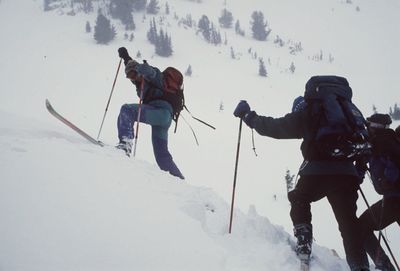Report offers insight into Eagle Cap tragedy

Persisting snowpack weakness combined with wind-loaded snow on steep terrain last month contributed to the first avalanche fatality in Northeastern Oregon’s Wallowa Mountains since 1982.
Roger Roepke, 50, a former Spokane resident and Badlands Cycling Club officer who moved to Enterprise, Ore., was killed in the Eagle Cap Wilderness March 7 in the Aneroid Basin avalanche. An official incident report was released Tuesday.
Avalanche professionals and backcountry skiing enthusiasts are poring through details of the report to search for clues to help them understand and avoid another incident in the popular backcountry skiing region.
“I researched this accident as a volunteer simply because it was the one thing I could do to support the family, skiers and the community,” said Roger Averbeck, an avalanche educator who guided skiers in the Eagle Cap Wilderness for 14 years before selling his backcountry skiing business in 2007.
The Wallowa National Forest has no avalanche professionals to forecast avalanche danger or detail incidents, Forest Service officials confirmed. The 1982 avalanche fatality in the Wallowas also was in the Aneroid Basin.
Roepke was skiing off 8,500-foot Lookout Mountain on a northerly slope with his son Erich, 15, and Don Woodhouse, 53, of Vancouver, Wash., when the avalanche occurred about 12:45 p.m.
Erich Roepke was partially buried up to his neck in the slide, but was uninjured and dug out by another group of skiers within minutes.
Woodhouse was completely buried, but said he managed to move his arm back and forth as the slide lost momentum to clear a breathing space in front of his face before the snow stopped and packed around him.
He was found with within about 10 minutes with the help of avalanche transceivers – skiers and rescuers involved wore transceivers and carried probes and shovels. Woodhouse was extricated and helped with the search for Roepke.
The report indicates that Roepke, who was lowest on the slope when the slab avalanche triggered, was located about 25 minutes after the avalanche. After another five minutes of shoveling, rescuers uncovered his head, which was under about 5 feet of snow with no air pocket around his face. CPR was administered, but medical officials confirmed he’d died of asphyxiation.
Following are key details in Averbeck’s report followed by his observations from a telephone interview this week:
•The avalanche advisory from the Payette Avalanche Center in McCall, 50 miles to the east, rated steep northerly slopes in the high alpine as a considerable avalanche hazard on the day of the accident.
“You can’t necessarily apply a forecast made for mountains 50 miles away. The conditions in the Wallowas could have been better or worse,” Averbeck said. “An avalanche forecast is simply an advisory.”
•Skiers tracking the winter snow profile were concerned about a persistent weak structure combined with a seemingly solid, strong, bridging slab.
“This was a complex snowpack. Skiers would dig pits and do sheer tests and get the impression of stability, but the history of the snowpack warranted caution,” Averbeck said.
•The snow profile pit the victims of the Aneroid avalanche dug at 8,400 feet that morning was on the east aspect in a wind deposition zone. They concluded the slope had “moderate stability.”
“In my opinion, the snow pit was not a representative location for the snow that ended up releasing,” Averbeck said.
•The avalanche slope had complex layering caused by cross-loading from winds that blow from different directions and leave no telltale cornice above.
“I’ve used slides of that slope in the past in avalanche courses as an example of cross-wind loading,” Averbeck said, noting that while there’s no cornice, the visual observation of snow “pillows” indicate the cross-wind deposition. Evidence of previous avalanches also are clues, he added.
•Other members of the party staying at the Aneroid Lake cabins had skied the Lookout Mountain slope the morning of the accident.
“With each run, the skiers moved farther north for fresh tracks,” Averbeck said, noting that time of day and angles of ski tracks are among many factors that can trigger an slide.
•During the rescue, a “false strike” by an avalanche transceiver distracted rescuers for about 10 minutes of futile digging until they realized that one of the rescuer’s transceivers had automatically switched from search to transmit mode.
“A particular brand of transceivers reverts back to transmit in 8 minutes,” Averbeck explained. “It’s important to understand how these devices work. In this case, I don’t think it would have changed the outcome.”
Averbeck said he presented his lengthy report to Roepke’s wife and children before releasing it to the Northwest Avalanche Center for review and release.
“My whole focus for the report was lessons learned rather than blame or responsibility,” Averbeck said.
“I had cooperation from the Forest Service, the sheriff’s search and rescue and guides who work in the area.”
“I have the benefit of years of experience guiding skiers in those mountains and observing the conditions,” he said. “But use is increasing in the Wallowas, and with new gear more people are getting in farther and higher.
“We need to be always learning.”